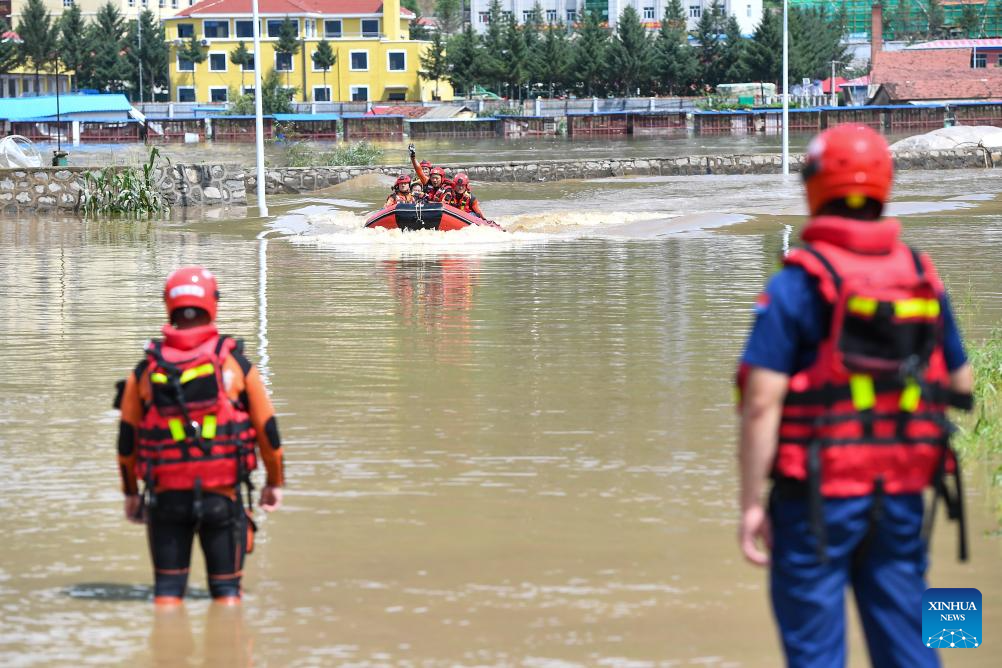
CHANGSHA/BEIJING – At least seven people were confirmed dead and three others missing after in torrential rain in a mountainous part of Hunan province, while the authorities issued orange alerts for heavy rain in several northern and western districts of Beijing on Tuesday.
According to the Beijing municipal meteorological department, heavy rain started to lash the city on Monday at midnight. By 10 am Tuesday, the average precipitation of the city reached 42.9 mm, with the maximum rainfall recorded in Changping District.
The districts that issued the orange alert, the second-highest level in China’s four-tier warning system, for rainstorms are Shijingshan, Haidian, Mentougou, Changping and Huairou.
Train services have been suspended on the railway linking Huairou and Miyun districts, and between Tongzhou and Miyun districts.
The Beijing Water Authority and the Beijing Meteorological Service jointly issued flash flood warnings, as the risk remained high in the suburban districts of Miyun, Pinggu, Yanqing and Huairou. They also gave a waterlogging warning to urban districts of Chaoyang, Fengtai, Shijingshan, Haidian, Tongzhou, Changping and Daxing.
7 dead, 3 missing in Hunan
The flood control and drought relief headquarters of the city of Zixing in Hunan reported that four people died and three remain missing in four villages in Zhoumensi town and Bamianshan Yao township.
Three others villagers from Yongxing county in the city of Chenzhou also died. A rain-triggered mudflow claimed their lives after they went missing last Wednesday while patrolling the mountains, according to the county's emergency management bureau.
The city of Zixing has received record precipitation since Friday due to the impact of Typhoon Gaemi, with 24-hour rainfall exceeding 645 mm at one spot.
READ MORE: Hunan landslide kills 15, with six others injured
The rain has toppled or damaged the dwellings of 867 households in the city and caused 1,345 cases of road cave-ins. Officials said communications with many villages were unstable, making it difficult for timely updates of the situation.
The city has dispatched more than 5,400 professional rescuers. A total of 11,379 people have been evacuated for safety concerns.
On Tuesday morning, volunteers were seen loading bottled water, rice and cooking oil onto a helicopter parked on the sports ground of Zixing No.1 Middle School.
Since Monday, helicopters have been taking off from the school to air-drop supplies to disaster-hit areas where rain-triggered landslides have disrupted road traffic and telecommunications.
Level-IV emergency response
Meanwhile, the State Flood Control and Drought Relief Headquarters activated a Level-IV emergency response to floods in the Beijing-Tianjin-Hebei region on Monday, in anticipation of severe rainfall and potential flooding.
From Monday to Tuesday, heavy to torrential rains are forecast in the region, giving rise to high risks of floods and waterlogging, according to the Ministry of Emergency Management (MEM).
To support local relief efforts, the MEM has worked together with the Ministry of Industry and Information Technology in dispatching unmanned aerial vehicles to central China's Hunan province.
The MEM and the National Food and Strategic Reserves Administration have also allocated disaster relief materials worth 4.41 million yuan (about $618,000) to northeast China's Liaoning province.
ALSO READ: China issues second-highest rainstorm warning
The China National Commission for Disaster Reduction activated a Level-IV disaster relief emergency response on Monday after rainstorms triggered floods in northeast China's Jilin province.
The Commission has dispatched a team to guide and assist Jilin with disaster relief work and rescue efforts.
China has a four-tier emergency response system for flood control, with Level I being the most urgent response.


